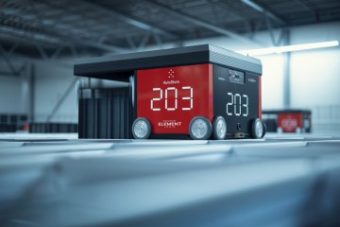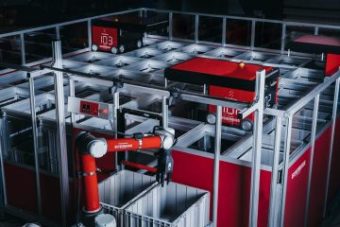Six types of ASRS for warehouse automation: how to pick the right one
Automated storage and retrieval systems (ASRS) – with their proven ability to optimise order fulfilment and warehouse efficiencies – offer the competitive advantage required in today’s fast-moving and unpredictable intralogistics environment. But what is an ASRS?

At its core, an ASRS is a computer-controlled inventory management system that streamlines the handling, storing, and retrieving items in a warehouse. However, there are numerous types of ASRS (which will be explored in this article), with some being more advanced than others, and it’s important to be aware of the differences.
What are the benefits of an ASRS?
Since available warehouse space is at a premium, one of the biggest advantages of modern ASRS systems is their ability to achieve higher storage density by maximising the warehouse space, including both the floor and the height. Operating in concert with a warehouse control system (WCS), an ASRS solution optimises product storage, picking strategies, and overall warehouse throughput.
Labour costs represent the bulk of the expenses of running a warehouse. Automation can reduce labour overheads significantly. Optimised order flow and enhanced ergonomics also improve warehouse safety, while limiting the physical impact on employees.
Moving orders efficiently and accurately into and out of the warehouse is essential. Choosing the right type of ASRS option can quickly lead to a radical increase in throughput and a fast return on investment.
Types of ASRS systems
The e-commerce boom has seen a proliferation of various types of ASRS technologies capable of handling different volumes, types, and velocities of non-palletised inventory. The one you choose will ultimately depend on your specific operation, the storage density your facility needs, your throughput goals, and your budget. Based on how they deliver goods, the ASRS technologies can generally be divided into three main categories:
- Shelf-based picking (where an operator receives an entire shelf or tray of product)
- Bin-based picking (where an operator receives individual bins with a certain quantity of product)
- Robotic picking (where robots pick products and deliver them to an operator)
The technologies used in an ASRS dictate its type, of which there are several. Let’s look briefly at six of the most prominent types of automated storage and retrieval systems.
1. Carousel-based ASRS
Available as either horizontal or vertical carousels, these systems comprise trays of inventory that rotate continuously along a track. Should the operator request a specific item, the carousel automatically rotates to provide access to the tray that contains the bin with the required item.
Although reliable and cost-effective, they have been around for decades, and more modern options may offer even greater efficiency. Additionally, they only allow one tray to be delivered at a time, so productivity is limited by how many commonly ordered products can fit into a single tray. To increase throughput, additional whole machines need to be added and then inventory needs to either be split across multiple machines, or a separate consolidation process needs to be added.
2. Vertical lift module (VLM) ASRS
These modules decrease the storage footprint by holding trays vertically in an elevator-like system. It consists of an inserter/extractor in the middle with an enclosed column of trays on either side. When an operator requests an item, the inserter/extractor picks the correct tray and delivers it.
Tray return can be either fixed (back to the same shelf) or dynamic, where the system automatically adjusts when inventory changes. These systems are particularly beneficial in warehouses with inventory of odd sizes: things like wellington boots, or long, thin items work well. Similarly to the carousel ASRS, their main drawback is that they can only handle one tray at a time, so productivity is limited.
3. Mini-load ASRS
Mini-loads feature a single crane per aisle. These are on rails or wheels to handle loads in totes, cases or trays.
The system is good for full case picking operations, like store replenishment or operations where minimum amounts are ordered. However, they are considered unreliable because the technology is very old and all of the work is reliant on one crane: if that breaks down or malfunctions, it can cause huge disruption.
4. Robotic shuttle-based ASRS
This dynamic storage solution uses robotic shuttles that travel independently along narrow rails to quickly retrieve and deliver inventory to a workstation. Depending on the warehouse’s needs, it can be tailored to operate on a single level or across multiple levels.
However, these solutions can’t be easily adapted because they require complex conveying systems at their front to get the right product to the right workstation, and they need to operate in very strict ways to be efficient. If there is a sudden unexpected shift in demand – like an earlier winter – and the demand for cold-weather clothes shoots up – the system won’t be efficient because all of the stock will be in the wrong place.
The benefit of these systems is that they are very high speed and can achieve very high presentation rates, so they are commonly seen in high throughput environments. However, to take advantage of this speed, they need a lot of additional resources and energy.
These systems do everything mini-load ASRS can do but better, albeit at a higher cost. They can be considered the successor to the mini-load.
5. Robotic cube-based ASRS
Comprised of stacked bins in a dense cube, many warehouse automation specialists view this type of ASRS, such as AutoStore, as the most modern and advanced available. Smart robots run across the overlaid grid independently to shuffle, sort and retrieve bins, bringing them to a workstation (port) for order picking. The robots are connected wirelessly to the system and charge themselves when not in use. A controller and built-in software keep track of everything.
The system provides a superior level of storage density, making it the ideal solution where warehouse space is limited, such as a micro-fulfilment centre. Modular design makes the system easy to configure as throughput demands change. Highly scalable and flexible, it is the only solution where every component can be easily added independently.
Additionally, AutoStore is the only system that enables a complete pick and pack process because no other system has the ability to get all products to any bin, and to any operator workstation, via any robot, without requiring complex conveying systems to either be built into, or built externally, to achieve the same thing.

6. Floor robots
An honourable mention here goes to floor robots: floor robots are not technically ASRS systems, but are still an option in optimising your warehouse. These solutions keep inventory portable by either keeping it on storage shelving where a fleet of mobile robots retrieve and transport items to an operator, or take the picking tote to a set area of shelving (with the operators remaining there). The robots can either be automated guided vehicles (AGVs) that travel along a fixed, guided path or autonomous mobile robots (AMRs) that can move more independently and intelligently.
Floor robots are quick and easy to install. However, they are somewhat limited by the load they can carry, pose some safety risks, and comparatively to other options, require a fair bit of space.
Find the right type of ASRS for your business
With an ASRS system, manufacturers, warehouses and distribution centres can take confidence in the many benefits that automation provides. Whether it’s the right option for your operation will largely depend on the specifics of your business.
Element Logic is a leading warehouse automation company, specialising in optimising warehouses with efficient systems, including AutoStore. You can contact an Element Logic expert today to help you evaluate your current and future operations, and to select the ASRS best suited to your operational needs.



